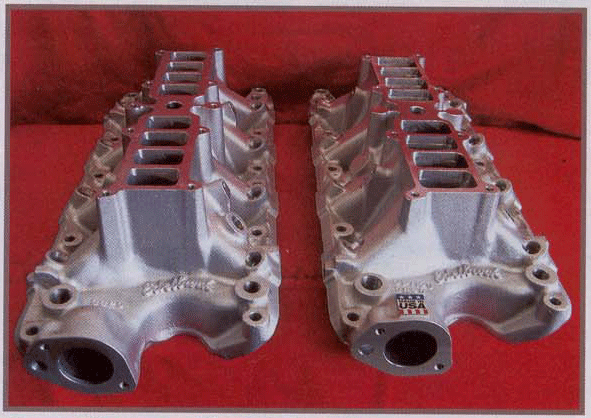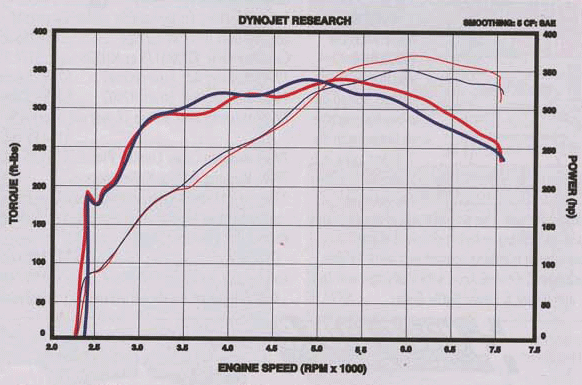It's a Performer Too!
BY MICHAEL GALIMI PHOTOGRAPHY COURTESY OF ANDERSON FORD MOTORSPORT
The 302 is still one if the most popular engines despite being eliminated from new Mustangs at dealership nine years ago. So it is no surprise when companies release products and continue to refine the power making abilities of our favorite pushrod engine. One company that has been on the forefront of parts manufacturing in Edelbrock and it simply loves the little small-block Ford. Its catalog offers several different components for all Mustangs and one of the largest product lines is the 5.0 EFI intake manifold section. The company first released the Performer intake manifold, which is perfect for mildly modified engines that operate between 1,500-6,000 rpm. When an enthusiast decides to go a bit faster and rev a little bit higher. Edelbrock recommends a Performer RPM 5.0 intake manifold.
The Test Mule: Jason Moore's innocent looking 89 Mustang coupe. The engine was bored to 4.030 inches and has DSS pistons, which raised the compression slightly and places the engine size at 306 cl. It was topped off with a set of TFS Twisted Wedge heads that featured an AFM Stage 3 port job. Other places of the induction system include a Pro-M 80mm MAS, AFM Power Pipe, 75mm throttle body and AFM N-91 camshaft.

Here is Moore’s engine with the Performer RPM 5.0 intake. The maximum horsepower at the rear tires with this intake was 348.7. The long and narrow runners were not the ideal choice for the rpm levels of Moore’s 306.
Appearance is vastly different, the Performer RPM 5.0 is on the top while the new Performer RPM II is on the bottom, Edelbrock took the time to redesign the upper intake to ensure the air flowed through it properly.
The Performer RPM II made a big difference in horsepower and torque. The peak numbers at the rear tires with the RPM II was 367.6 rwhp and 338.8 lb-ft rwtq. When the engine hit 5,000 rpm the power figures started to distance themselves from the Performer RPM 5.0.

It is apparent the runners are differently sized for their application. The runners seem to be similarly shaped, but the cross width and length of the runners are quite different.
Essentially the upper plenum has shorter runners to increase its optimum operating range up to 6,200 or so. Those two intakes are great when adding a mild camshaft and out-of-the-box cylinder heads or mildly ported cylinder heads to a stock short-block.
Being a gearhead means that eventually it comes time to upgrade to something a hit more radical. Most of the time it is not an all-out race engine, but rather a wilder camshaft with opened up ports in the cylinder heads Also the short-block will undoubtedly eel rebuilt and the compression bumped to around 10.5:1—perfect for street-driven Mustangs. The engine requires a bit more airflow than the Performer RPM 5.0 in capable of providing, yet for the longest time the only other choice from Edelbrock was a Victor 5.0 intake. It is not ideal fora street engine due to its short runners, but at the same time the Performer RPM 5.0 can not keep up with our hypothetical engine. Edelbrock's engineers came up with a new intake to fill the void between those two outstanding intakes; it is the Performer RPM II.
To test the newly-released Performer RPM II, we turned to Rick Anderson and Anderson Ford Motorsport.

You can see the two power curves side by side, the red lines are the Performer RPM II and the blue lines represent the Performer RPM 5.0. The RPM II takes off rapidly and makes more power from 5,100 rpm to the redline.

Here is the belly view of the two intakes. As you can see Edelbrock used the Performer RPM 5.0 as the base and further modified them to flow more air and thus change the power band.
He has extensive knowledge in the field of 5- and 4.6-liter performance, which made him perfect to conduct this comparison. This test was to compare the amount of power the Performer RPM II will make over the Performer RPM 5.0 on a properly prepared engine.
Name: Moore .087
Title: Edelbrock RPM II
Acceleration from 2,400 to 7,100 rpm Absolute barometric pressure:
29.08 In HG
Vapor Pressure: 0.44 in. MG
Intake Air Temperature: 71.3-degress F
|
RPM |
Torque |
Power |
|
2,500 |
172.0 |
81.9 |
|
2,600 |
191.1 |
94.6 |
|
2,700 |
201.3 |
103.3 |
|
2,800 |
232.5 |
124.0 |
|
2,900 |
256.7 |
141.7 |
|
3,000 |
271.3 |
155.0 |
|
3,100 |
281.4 |
166.1 |
|
3,200 |
289.9 |
176.6 |
|
3,300 |
293.4 |
184.3 |
|
3,400 |
292.1 |
189.1 |
|
3,500 |
290.6 |
193.7 |
|
3,600 |
292.4 |
200.4 |
|
3,700 |
295.3 |
208.0 |
|
3,800 |
300.4 |
217.3 |
|
3,900 |
306.6 |
227.7 |
|
4,000 |
312.9 |
238.3 |
|
4,100 |
317.3 |
247.7 |
|
4,200 |
318.7 |
254.9 |
|
4,300 |
316.6 |
259.2 |
|
4,400 |
315.1 |
264.0 |
|
4,500 |
313.9 |
268.9 |
|
4,600 |
314.8 |
275.7 |
|
4,700 |
318.1 |
284.7 |
|
4,800 |
323.5 |
295.7 |
|
4,900 |
329.2 |
307.1 |
|
5,000 |
334.5 |
318.5 |
|
5,100 |
338.2 |
328.4 |
|
5,200 |
338.8 |
335.5 |
|
5,300 |
338.6 |
341.7 |
|
5,400 |
337.7 |
347.2 |
|
5,500 |
335.1 |
350.9 |
|
5,600 |
332.1 |
354.1 |
|
5,700 |
329.6 |
357.7 |
|
5,800 |
326.5 |
360.6 |
|
5,900 |
324.2 |
364.2 |
|
6,000 |
320.2 |
365.7 |
|
6,100 |
316.5 |
367.6 |
|
6,200 |
310.9 |
367.0 |
|
6,300 |
305.5 |
366.5 |
|
6,400 |
299.5 |
365.0 |
|
6,500 |
292.8 |
362.4 |
|
6,600 |
285.5 |
358.7 |
|
6,700 |
276.8 |
353.1 |
|
6,800 |
270.3 |
349.9 |
|
6,900 |
264.6 |
347.6 |
|
7,000 |
259.4 |
345.7 |
|
7,100 |
256.7 |
347.0 |

The only modification necessary to the Performer II intake manifoldwork was togrind the throttlebody opening.Edelbrock sends the Intake with 70mm holes, whereas our test vehiclehas a 75mm throttle body.
Performer RPM 5.0 on a properly prepared engine. Before the RPM II was released, our test vehicle suffered from an intake restriction because the combination required a bigger intake. The Victor 5.0 was definitely out of the question due to its rpm limit and street use. "If you are using the stock rev limiter then you will never need an RPM II,”says Anderson.
Name: Moore .083
Title: Edelbrock RPM 5.0
Acceleration from 2,400 to 7,100 rpm Absolute barometric pressure:
29.11 in HG
Vapor Pressure: 0.42 in HG
Intake Air Temperature: 70.1-degress F
|
RPM |
Torque |
Power |
|
2,500 |
170.9 |
813 |
|
2,600 |
183.8 |
91.0 |
|
2,700 |
198.2 |
101.9 |
|
2,800 |
221.8 |
118.3 |
|
2,900 |
252.2 |
139.3 |
|
3,000 |
272.7 |
155.8 |
|
3,100 |
285.7 |
168.6 |
|
3,200 |
290.0 |
176.7 |
|
3,300 |
292.6 |
183.8 |
|
3,400 |
295.2 |
191.1 |
|
3,500 |
302.0 |
201.3 |
|
3,600 |
306.9 |
210.4 |
|
3,700 |
313.5 |
220.8 |
|
3,800 |
319.1 |
230.9 |
|
3,900 |
321.5 |
238.7 |
|
4,000 |
320.6 |
244.2 |
|
4,100 |
317.6 |
247.9 |
|
4,200 |
315.4 |
252.2 |
|
4,300 |
314.6 |
257.6 |
|
4,400 |
318.1 |
266.5 |
|
4,500 |
324.1 |
277.7 |
|
4,600 |
330.8 |
289.7 |
|
4,700 |
335.9 |
300.6 |
|
4,800 |
339.2 |
310.0 |
|
4,900 |
339.9 |
317.1 |
|
5,000 |
336.8 |
320.6 |
|
5,100 |
334.4 |
324.7 |
|
5,200 |
329.9 |
326.6 |
|
5,300 |
326.9 |
329.9 |
|
5,400 |
324.6 |
333.7 |
|
5,500 |
322.1 |
337.3 |
|
5,600 |
319.6 |
340.9 |
|
5,700 |
317.4 |
344.5 |
|
5,800 |
314.8 |
347.7 |
|
5,900 |
310.4 |
348.7 |
|
6,000 |
304.9 |
348.3 |
|
6,100 |
298.2 |
346.4 |
|
6,200 |
292.1 |
344.8 |
|
6,300 |
286.3 |
343.4 |
|
6,400 |
279.1 |
340.1 |
|
6,500 |
272.6 |
337.3 |
|
6,600 |
267.5 |
336.1 |
|
6,700 |
261.9 |
334.1 |
|
6,800 |
256.6 |
332.2 |
|
6,900 |
252.3 |
331.4 |
|
7,000 |
248.6 |
331.3 |
|
7,100 |
243.5 |
329.1 |

Swapping the intakes is straight forward. To save time, the car was left strapped to the dyno.
"The Performer RPM 5.0 was designed for 6,000-6,200 rpm and the RPM II is good for around 6,500 to 6,700.”
The test vehicle belongs to longtime Anderson Ford Motorsport customer Jason Moore. It is a naturally aspirated '89 Mustang coupe. The engine is 306 ci with DSS replacement pistons that bumped the compression ratio slightly. A set of TFS Twisted Wedge heads have been put through the porting room and are now classified as AFM Stage 3. The camshaft is one of Anderson's naturally aspirated specific pieces and it is called the N-91. It is still a hydraulic roller unit. Making up the intake tract is a Pro-M 80mm MAS that is attached to the AFM Power Pipe and 75mm throttle body. A complete Bassani Exhaust system from headers to tailpipe exhausts the spent gases. In a nutshell the PMS computer adds fuel. adjusts timing, and removes the factory rev limiter. Handling the horsepower is a factory T-5, AFM aluminum flywheel. Hi-Rev clutch, and 4.56 gears.
Here are the numbers: With the Performer RPM 5.0 intake, the engine produced a maximum horsepower reading of 348.7 at the rear tires with 339.9 lb-ft of torque. When Anderson swapped intakes and made some pulls with the Performer RPM II the maximum numbers were 367.6 hp and 338.8 ft-lb of torque. The results are rear-wheel numbers and flywheel power will be higher. As a rule of thumb a manual transmission-equipped car will have an 10-18 percent difference in power. Anderson estimated this car to have about 430 hp or so. The only modification made to the intake was to grind the throttle body opening to fit the 75mni unit. Edelbrock manufacturers the intake with a 70mm hole.
Anderson had a lot of complimentary things to say about the new piece, “The RPM II has better increases than what Edelbrock claims. They did a good job with it; we gained almost 20 hp at the rear wheels.” He also pointed out that up until 5.000 rpm the Performer RPM has more torque, but at 6,200 rpm the RPM II dominates. If you analyze the results at 5,100 rpm the RPM II makes more power all the way through to the redline on Moore's engine. "If you build a motor around this intake you will be happy with the results," concluded Anderson.
SOURCES
ANDERSON FORD
MOTORSPORT
Route 10 West
Dept. MMFF
P.O. Box 638
Clinton, IL 61727
www.andersonfordmotorsport.com
EDLEBROCK
2700 California Street
Dept. MMFF
Torrance, CA 90503
www.edelbrock.com
